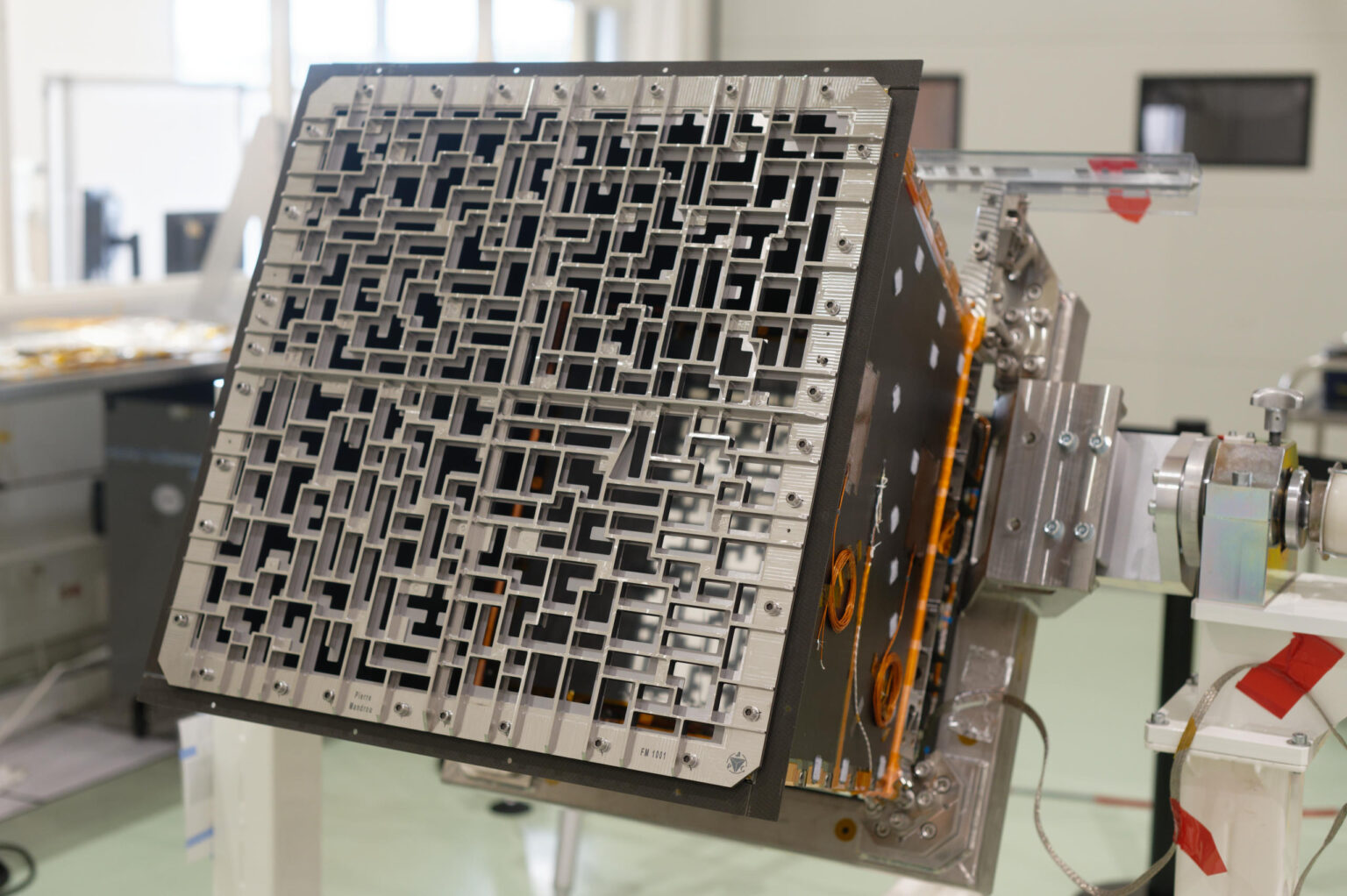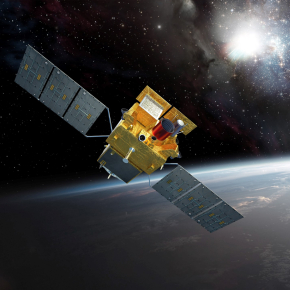Launch of the SVOM gamma-ray burst detection satellite: a new chapter opens up for astroparticle physics at IN2P3
The launch of the SVOM satellite on 22 June will mark the culmination of a long technological odyssey led by several Chinese and French institutes, including CNRS through its IN2P3 and INSU institutes. For astroparticle physicists, the adventure is just beginning. The launch marks the start of an ambitious physics programme aimed at studying the transient sky, with the main objective of unlocking the secrets of gamma-ray bursts, the brief but intense gamma-ray emissions from distant cosmic sources. Observation strategy, responsiveness, wavelength coverage... with several instruments in continuous dialogue with a network of ground-based telescopes, SVOM has a number of assets to help reveal the origins of these mysterious phenomena, while contributing to the development of multi-messenger astronomy.
The SVOM (Space Variable Object Monitor) satellite is preparing to propel astroparticle physics into a new era. This assembly of four instruments developed mainly between China and France (CEA, CNES and CNRS with INSU and IN2P3) will reach its equatorial orbit on 22 June, following a launch from the Xichang base in southern China. The aim of the mission is to identify more precisely the origin of gamma-ray bursts, very short bursts of ultra-high-energy gamma radiation that signal the end of the life of massive stars or the merging of neutron stars. But it will also be observing possible ultra-long gamma-ray bursts, discovering new sources, complementing observations of gravitational waves and cosmic neutrinos... a busy programme to be carried out over the satellite's planned five years of operation.
Detecting gamma-ray bursts
SVOM is not the first space observatory to devote itself to the study of gamma-ray bursts - NASA's SWIFT and Fermi observatories have been successfully tackling this arduous task since 2004 and 2008 respectively. SVOM's instruments have been optimised to achieve excellent performance in terms of responsiveness, precision and the amount of data collected. First and foremost, responsiveness is a crucial factor in the hunt for gamma-ray bursts, which are fleeting species. "The initial gamma-ray burst of a gamma-ray burst, the 'prompt' emission, can be as short as 100 milliseconds and more rarely exceeds one hundred seconds. In the process of detecting and alerting ground-based telescopes, every second counts in studying the direct effects of the prompt emission", explains Cyril Lachaud, head of the SVOM project at IN2P3. In the commonly accepted physical scenario, prompt emission comes from internal shocks within a jet of ultra-relativistic matter.
In practice, it is the ECLAIRs instrument, probing a very large portion of the night sky, that first detects and locates the gamma-ray burst. While the satellite reorients itself to analyse the signal in depth using more precise instruments, an alert is sent out to a terrestrial network of VHF antennas positioned all around the globe, on either side of the equator. This signal will be processed in less than thirty seconds by the French Science Center, housed at the IN2P3 computing centre in Villeurbanne, which will reconstitute it and alert the SVOM ground-based telescopes and the community as a whole to contribute to the study of the outburst.
One of SVOM's strengths lies in its ability to pinpoint the origin of gamma-ray bursts in the Universe with excellent precision, by supplementing the initial signals received by ECLAIRs with analyses from the MXT (a contribution from France, the UK and Germany) and VT (a Chinese contribution) instruments. By observing X-rays and visible light respectively, these instruments will be able to pinpoint the position of the burst to within a few arcseconds.
SVOM's ground-based telescopes will also be used to obtain an initial estimate of the redshift, which will then be refined using the spectroscopic capabilities of the large telescopes. "The measurement of redshift is the nerve centre of gamma-ray physics. The redshift tells us how far the source is from the Earth. Without this measurement, we are missing a fundamental piece of information for constraining our models. Measuring the redshift for most of the gamma-ray bursts discovered by SVOM is a promise that the community is eagerly awaiting", comments Cyril Lachaud.
Finally, SVOM will stand out for its multi-wavelength observations, on the one hand of prompt emission from keV to MeV with the GRM gamma monitor (Chinese instrument) and ground-based robotic telescopes such as Colibri (Franco-Mexican instrument), which operates in the visible and near-infrared domains, and on the other hand of afterglow emission. Afterglow emission is produced when the high-energy jet interacts with the interstellar medium; it remains detectable for up to several months in an energy range from very high-energy gamma rays to radio waves. Extensive characterisation of the properties of this afterglow by the range of instruments on board the satellite and the ground-based telescopes, such as the variations observed in the light curves, will provide physicists with invaluable data for understanding the phenomenon of gamma-ray bursts.
Unmasking gamma-ray bursts
To develop the SVOM satellite, five Chinese institutes have joined forces with CNES, CEA, INSU and IN2P3. IN2P3 is contributing to all aspects of the project, from hardware to software, from Earth to space, through four of its laboratories: APC (Paris), CPPM (Marseille), IJCLab (Orsay) and LUPM (Montpellier). One of the Institute's major contributions to the SVOM mission is the coded mask for the ECLAIRs instrument, which is the responsibility of the APC. This tantalum plate, with its labyrinthine pattern and 54-centimetre holes for the active part, is a vital component of the ECLAIRs detector. Since it is impossible to focus the radiation using mirrors, as is customary for most telescopes, the coded mask makes it possible to find the position of the source of the gamma-ray burst from the shadow it casts on the detection plane: each source emitted from a given position corresponds to a unique shadow.

"The principle of the coded mask is simple; it's a technique that's been around since the 70s. Putting it into practice, on the other hand, was a real challenge. We had to design a device riddled with holes, and therefore structurally fragile, but capable of withstanding the intense vibrations of a rocket launch. Teams on previous missions had solved this problem by placing the opaque elements on a support structure that blocked the holes and unfortunately blocked some of the useful radiation, particularly below 15 keV. For SVOM, this solution was out of the question because we wanted to capture all the photons, up to at least 4 KeV", explains Cyril Lachaud, scientific manager of the coded mask at the APC.
The solution is as elegant as it is technically delicate: to reinforce the coded mask without obstructing the holes through which the gamma rays will pass, the APC's mechanical group chose to double the tantalum mask with two titanium plates whose shape perfectly matches that of the coded mask - they therefore also have holes and are self-supporting like the tantalum mask. To minimise the risk of breakage, the upper titanium plate was machined entirely, without welding, from a single 2cm-thick block of titanium. On the strength of this complex assembly, the prototype coded mask developed at APC has successfully passed the resistance tests on the Airbus vibration chamber in Élancourt: its twin will take off on 22 June, attached to the ECLAIRs instrument, with the rest of the satellite.
IN2P3 contributions
In addition to this IN2P3 contribution to the satellite hardware, the institute has also been involved in the software field. The IJCLab laboratory developed the X-ray signal reconstruction software for MXT, an instrument that uses a reflection-based optical system to mimic the vision of decapods (the crab and lobster family). The IJCLab software is capable of reconstructing the X-ray photons one by one, then deducing their incident direction from the cross pattern formed by their accumulation on the detection plane, which is characteristic of this original optical system. "This is how we can locate the X-ray source in the sky. It's important information that we bring back down to earth as quickly as possible", comments Florent Robinet, a researcher at IJCLab.
The APC is developing the scientific pipeline for processing ground-based ECLAIR data. This is a delicate task, considerably complicated by the regular passage of the Earth in front of the telescope. "Thanks to this pipeline, we will be able to measure the properties of transient sources and alert the community to enable multi-wavelength monitoring to better characterise and understand these events", comments Floriane Cangémi, researcher at the APC.
LUPM is responsible for the real-time analysis pipelines that combine information from ECLAIRs and GRMs to characterise high-energy gamma-ray bursts.These analyses will make it possible to extract properties that are fundamental to understanding the prompt emission of the bursts."Although the internal shock model is satisfactory in more ways than one to explain the origin of the prompt emission, it does not explain all the observations.With SVOM, our aim is to improve our understanding of one of the most energetic phenomena in the Universe", comments Frédéric Piron, a researcher at LUPM.
With the SVOM project, IN2P3 has its head in the stars, but its feet firmly on the ground. This is particularly the case with the COLIBRI telescope, located in Mexico, the fruit of collaboration between Mexico and France, with the CPPM as a partner."The aim of COLIBRI is to rapidly find the counterpart of gamma-ray bursts detected by ECLAIRs and to characterise the afterglow with the light curve, the spectrum, the redshift estimate and the properties of the burst's environment.The CPPM is involved in the development of the telescope, its operation and the link with the French Science Center," explains Damien Dornic, a researcher at the Marseille laboratory.
Finally, it should be noted that once the physics programme is launched, the four IN2P3 laboratories (APC, CPPM, IJCLab and LUPM) will be involved in interpreting and analysing the data from the satellite.
The SVOM project is part of an ecosystem of instruments whose observations of certain cosmic phenomena complement each other.As such, the satellite will become a fully-fledged player in multi-messenger astronomy, and it is on this point that Cyril Lachaud concludes: "SVOM will be able to follow alerts from new generations of instruments supported by IN2P3 such as Virgo, KM3NeT, CTA, LSST... Thanks to the multi-wavelength observations of instruments from space and on the ground, SVOM will provide essential elements for a better understanding of the associated physical phenomena.Complementarity is an essential element of multi-messenger astronomy, which will be a key element of the SVOM mission."
